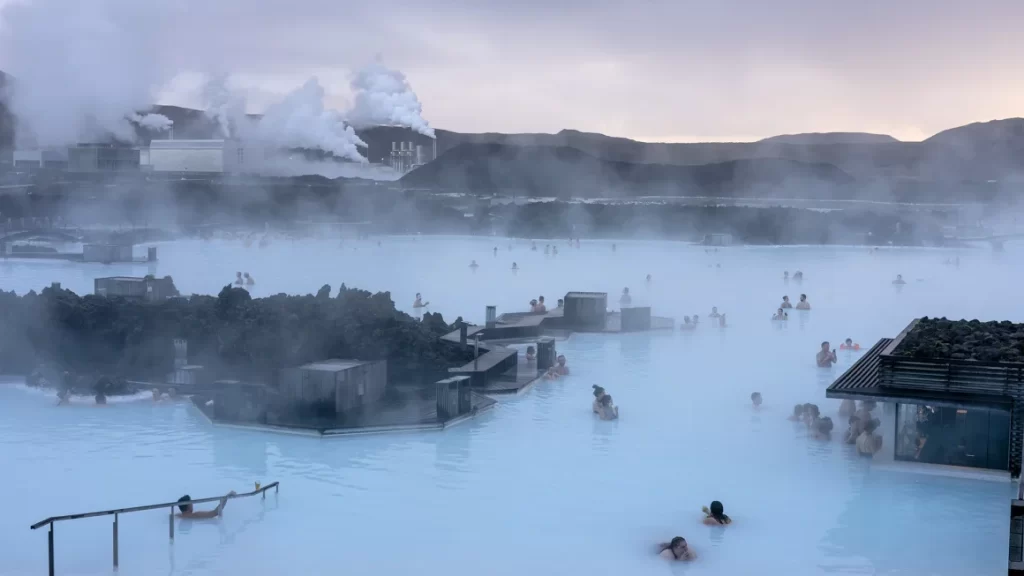News
Iceland’s Blue Lagoon: A Geothermal Oasis in the Face of Imminent Volcanic Activity
Nestled in the heart of Iceland’s enchanting landscapes, the Blue Lagoon, a world-renowned geothermal oasis, is currently facing a heightened state of emergency. Recent seismic activity in the vicinity has prompted the evacuation of this iconic destination and the nearby town of Grindavík. As the threat of an imminent volcanic eruption looms, authorities are taking swift measures to ensure the safety of both locals and the countless visitors who have marveled at the ethereal beauty of the Blue Lagoon. In this article, we delve into the unfolding situation, exploring the geological dynamics of the Reykjanes Peninsula, the impact on tourism in Iceland, and the delicate balance between harnessing natural wonders and managing the inherent risks of residing in a geologically active region. Let’s find out with nowglas.

In a dramatic turn of events, Iceland’s iconic Blue Lagoon, renowned for its ethereal geothermal waters, finds itself at the center of an emergency evacuation due to the looming threat of an imminent volcanic eruption. The country, nestled in the North Atlantic and celebrated for its striking landscapes, is no stranger to geological phenomena. However, the current situation has prompted authorities to take swift action to ensure the safety of both locals and visitors.
The alarm was raised as a result of heightened seismic activity in the vicinity of the Blue Lagoon, signaling potential volcanic unrest. Magma has been detected, flowing beneath the earth’s surface, and the depth of this molten rock—approximately four kilometers (2.5 miles)—has experts like volcanologist Thorvaldur Thordarson expressing concerns about the possibility of an eruption occurring within a matter of hours.
The evacuation efforts extend beyond the confines of the Blue Lagoon, reaching the nearby town of Grindavík. The precautionary measures aim to safeguard the local population from potential volcanic hazards, including lava flows and ashfall. Authorities, overseeing the evacuation, have reported that the process is proceeding well, with the town having relatively few residents in recent days.
In response to the unfolding situation, the Blue Lagoon, a geothermal spa that has captivated visitors from around the globe, released an official statement on its website. The statement acknowledges the increased seismic activity a few kilometers away from the spa and announces the initiation of an evacuation. Operations at the Blue Lagoon will remain closed at least until the end of the coming Sunday, with a reassessment of the situation scheduled at that time. The spa management underscores its commitment to closely following guidelines and recommendations from authorities while working collaboratively to monitor the progression of events.
Situated less than an hour’s drive from Reykjavik, Iceland’s capital and largest city, the Blue Lagoon holds a special place among the country’s many tourist attractions. Located on the Reykjanes Peninsula, a geological wonder known for its unique features, the spa has become synonymous with relaxation, offering visitors the chance to soak in its milky-blue, comforting warm waters.
The Reykjanes Peninsula is characterized by its dynamic geological activity, featuring a rift valley, expansive lava fields, and volcanic cones. Unlike regions with a central volcano, the peninsula’s geological landscape is shaped by the movement of tectonic plates and the resultant seismic activity. Iceland, as one of the most active volcanic regions globally, experiences periodic volcanic events that contribute to its unique and ever-changing terrain.

The recent closure of the Blue Lagoon in November, following a swarm of 1,400 earthquakes within a 24-hour period, hinted at the region’s dynamic nature. While the spa resumed normal operations after a week, the current situation has elevated concerns about the potential escalation of volcanic activity in the area.
The ongoing evacuation efforts underscore the delicate balance between harnessing the natural beauty of geothermal wonders and managing the inherent risks associated with living in a geologically active region. The authorities’ response to safeguard both local communities and internationally beloved tourist destinations highlights the need for proactive measures and collaborative preparedness in regions prone to geological shifts.
As Iceland navigates the potential eruption threat near the Blue Lagoon, the world watches with a mix of concern and fascination. The incident serves as a reminder of the awe-inspiring yet unpredictable forces of nature, emphasizing the importance of scientific monitoring, preparedness, and community resilience in the face of such geological uncertainties.
As Iceland navigates this critical moment in its geological narrative, the closure and evacuation of the Blue Lagoon underscore the dynamic forces shaping the country’s landscapes. The incident serves as a poignant reminder of the coexistence between the allure of natural wonders and the potential hazards of living in a region characterized by seismic activity. It emphasizes the importance of scientific monitoring, proactive preparedness, and collaborative efforts to safeguard both communities and cherished tourist destinations. As the world watches the evolving situation, the resilience of Iceland’s people and their commitment to preserving the delicate balance between nature and human activity stand as a testament to the unpredictable yet awe-inspiring forces of the planet we call home.
See more: Latin American Women Take to the Streets in a Sea of Purple on International Women’s Day

